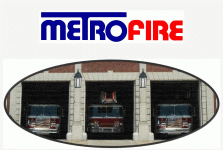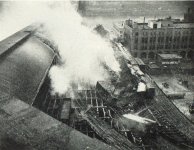Boston Mutual Aid running card from Mass MetroFire Mutual Aid System
Boston Fire Alarm still taps out signals including boxes struck, multiples and all-outs.
Boston Mutual Aid running card from Mass MetroFire Mutual Aid System

Some people probably do need a 10 alarm card.
From 1943 to 1950 the Pittsburgh Bureau of Fire had a chief named William Davis. His firehouse nickname was "Multiple Alarm". Much to the amusement of the troops, whenever he arrived on the fireground, regardless of the status of the fire, they knew he was gonna bang out another alarm.

beep beep, beep beep, beep beep, beep beep: beep-beep beep- beep- beep, All out box 1-2-1-1. Music to my ears.Whoaa!
STOP THE PRESSES!
At 0800 hours on 2/4/80, the Boston FD instituted the Computerized Alarm Assignment System (CAAS). This scheme allowed nine alarms to be transmitted for a five alarm incident. Instead of the fourth and fifth alarms, mutual aid would now occur on the sixth, seventh, eighth, and ninth alarms. On the ninth alarm 21 engines and 7 ladders will have been dispatched on the box.
Far more importantly on that date, previous orders were revoked and box preliminary and "All Out" signals were once again transmitted on the tapper and radio circuits.
Forty two years later, on 1/26/22, BFD had the computer system up the ante. Now, chief officers have a ten alarm running assignment at their fingertips which provides 22 engines , 8 ladders as well as fifth alarm mutual aid.
In other news; life forms have been discovered on Mars.
The great question hanging over the City of Boston.......Who is gonna win the betting pool for the first tenth alarm fire?beep beep, beep beep, beep beep, beep beep: beep-beep beep- beep- beep, All out box 1-2-1-1. Music to my ears.
Didn't Moe the Deputy's driver hit it for 9 alarms on Box 9-5221 in 1980?The great question hanging over the City of Boston.......Who is gonna win the betting pool for the first tenth alarm fire?
That was a bag job!Didn't Moe the Deputy's driver hit it for 9 alarms on Box 9-5221 in 1980?
In 1969-70 I buffed 25 Engine at Penn Avenue & 34th Street. All the guys were WWII vets and is where I learned of Chief Davis and the Wabash Terminal fire. In the basement was (in addition to the 1936 flood high water mark) an American LaFrance mini water tower with artillery wheels that I'm sure made the Wabash job.
Chief William Davis - Pittsburgh 1946
DOWNTOWN PITTSBURGH PERILED WHEN WABASH TERMINAL BURNS
By
Fire Engineering Staff
4.1.1946
DOWNTOWN PITTSBURGH PERILED WHEN WABASH TERMINAL BURNS
Second Serious Fire in Area in Two Weeks Causes $700,000 Loss, Injures 22 Firemen
A Staff Report
TERMED by firemen the worst fire they have had to fight in thirty years, a six-alarm blaze swept through the interlocking, overhead Wabash Terminal and twelve food and supply houses in a three-block area near the “Point” of Pittsburgh, Pa., on March 22. Forty carloads of butter, lard, sugar, dairy and other foodstuffs also burned. The loss exceeded $700,000.
Twenty-two firemen were hurt by falling debris and toppling walls in the “flash” blaze which quickly encompassed one building after another in the fivehour near-conflagration. Twelve hours after its start, which was reported as 11:10 P. M., eighteen streams were still being played on the fire. It was not until 5:30 A. M. that Fire Chief William Davis, in charge of the fire-fighters, was certain that the large eight-story Wabash Building itself wouldn’t be destroyed.
The Wabash trainshed is a 40-year downtown landmark. Railroad officials said that 100 carloads of edibles had been received daily in the station and much of it had been stored. Some passenger equipment as well as freight cars were in the station. The Wabash Terminal area which includes the trainshed contains a number of one, two and three story buildings connected with a large system of interlocking trestles. Most of these were used for storage and distribution of the food and beverage products.
Fire Covered Large Area—Arson Suspected
Although firemen said there have been bigger, more costly fires, none covered as large an area, and contained the same type of highly flammable materials,— food, fats, grease and oils which fed the flames.
A railroad night watchman, Richard Weidenheft saw a puff of smoke from the bakers’ supply house of J. R. Lloyd Co., 113 Ferry St., and yelled to an unidentified policeman across the street who telephoned the alarm. That was at 11:10 P. M. Additional alarms were sounded in rapid succession. Within forty-five minutes the flames had leaped completely out of control, involving building after building.
Suspicion of arson arose as city officials weighed the evidence received the day following the fire, while firemen still poured water into the smoking ruins. Following Chief Davis’s statement that he was going to investigate the origin of the blaze, Safety Director Farley said the investigation would be based on reports that the fire started in at least two points—possibly three, in the threeblock area.
The Director and Chief also criticized the large concentration of inflammable material in the warehouses and overhead trainshed — paint, coal, lumber and chemicals as well as foodstuffs— which were said to be responsible for the explosive spread of the fire.
Feeding on this material the fire leaped to the main building, the railroad trestles, eighteen freight cars and into the warehouses along First Avenue and Blockhouse Way. Dull explosions jarred the buildings at the height of the fire. Collapsing floors and walls drove sparks and flaming embers high in the air. For hours it was thought burning boxcars would topple into the Boulevard of the Allies as steel beams buckled from the heat. In the first three hours it is said the flames, fed largely by grease of all kinds, defied the tons of water thrown on the fire by the heavy concentration of Pittsburgh’s fire forces. Chief William Davis who directed the fire fighters despite a back injury received from a falling timber said “For hours, water had no effect on if.” Heavy smoke engulfed downtown Pittsburgh.
View attachment 16532
With the railroad trestle carrying the flames “like a fuse” as an observer described it, the fire raced within an hour from First to Fourth Avenue, where an overpass gap stopped the advance a few yards from the razed Jones & Brown Building where a 5-alarm fire, only two weeks before, anxiously menaced the Wabash Station.
Firemen were hampered by the difficulties in getting at the heart of the fire at the outset and finding commanding positions from which to cut it off and confine it. Intermingled with the odor of burning grease was the smell of chemicals. Mixed with the water on pavements. already made slippery by scorched food oils, was molasses which escaped from casks stored in warehouses.
A review of the firemen’s casualty list emphasizes the difficulties under which they bad to operate. Of the twenty-two men reported injured, four were hospitalized.
June 17, 1980Didn't Moe the Deputy's driver hit it for 9 alarms on Box 9-5221 in 1980?
Fire was in a RR yard adjacent to the Mass Pike. They had a private water system hooked up to the city but it had not been maintained.June 17, 1980
40 Western Ave, Allston
Box 5221
1st 9 alarm fire
3 Special Calls for 2 additional engines, each
